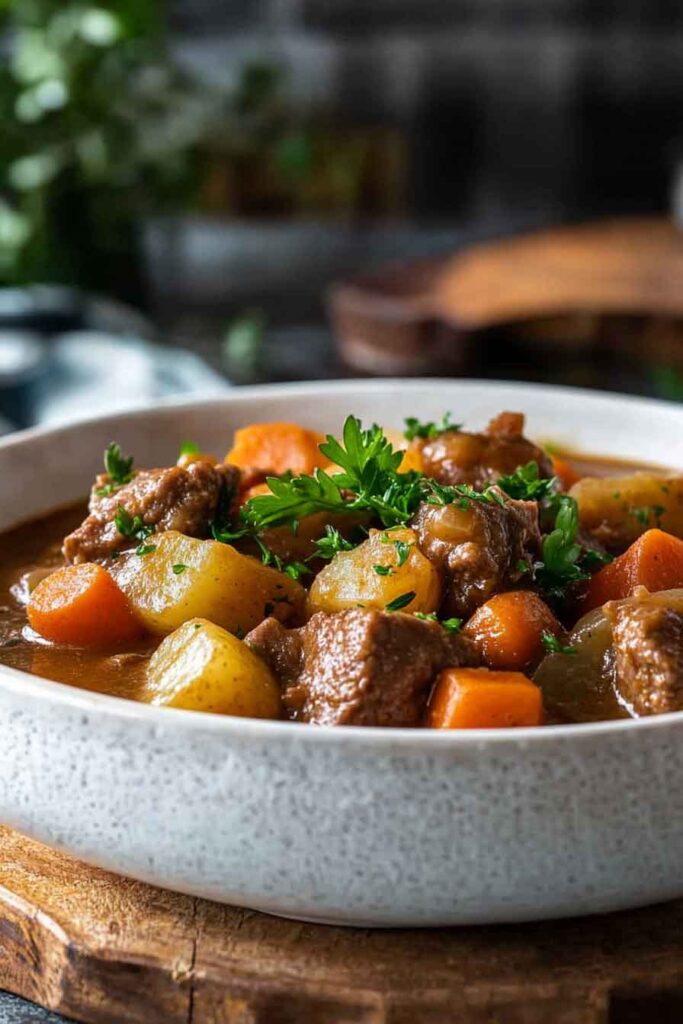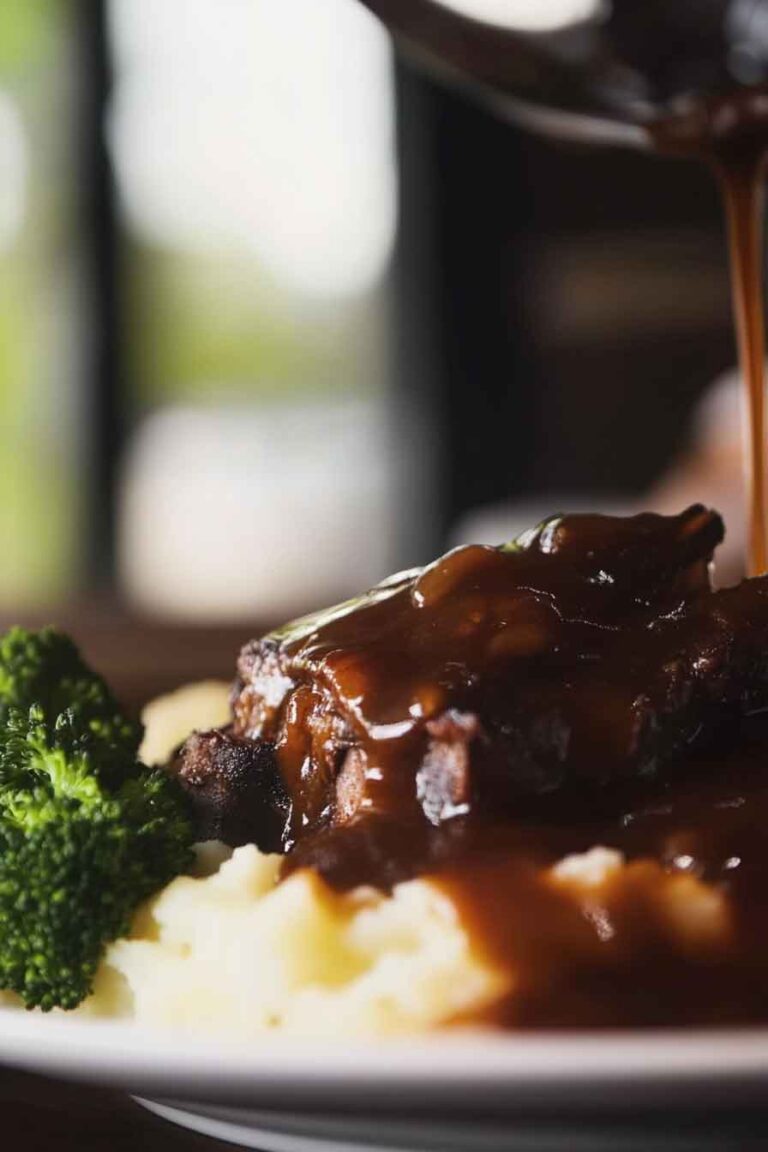Beef Stew: A Comforting Classic for Every Season
Craving something hearty and comforting? This beef stew is my go-to for any season—it’s rich, flavorful, and so satisfying.
The tender beef, savory broth, and hearty veggies blend together in the perfect way. I make it when I want a meal that feels like a big warm hug.
It’s easy to make, and it cooks low and slow for the best flavor. Plus, it gets better the longer it sits!
Let me show you how I make this classic stew. It’s the perfect dish for any occasion. Let’s dive in!
Top 5 Kitchen Essentials You Can Buy on Amazon

Why You’ll Love This Recipe
- Rich and Hearty: The slow-cooked beef and vegetables create a deeply flavorful and filling meal.
- Versatile Ingredients: You can easily customize this stew by adding or changing vegetables to suit your taste.
- Perfect for Meal Prep: Make a big batch for dinner tonight and enjoy leftovers throughout the week.
- Comfort Food: Whether served with crusty bread or over mashed potatoes, this stew is the ultimate comfort food.
- Easy to Make: The recipe requires simple ingredients and minimal hands-on time, leaving you with more time to relax.
What You Need to Know Before You Start
Prep Time & Cook Time:
Prep Time: 15 minutes
Cook Time: 2 hours
Total Time: About 2 hours and 15 minutes
Servings:
This recipe serves 6 people. If you’re expecting a crowd, feel free to double the recipe.
Difficulty:
This recipe is easy to follow, making it perfect for beginner and seasoned cooks alike.
Required Kitchen Tools
- Large Dutch oven or heavy-bottomed pot: For slow cooking the stew.
- Knife and cutting board: To chop the vegetables and beef.
- Wooden spoon or spatula: For stirring the stew.
- Measuring spoons and cups: To accurately measure the ingredients.
Ingredients for Beef Stew
This hearty beef stew requires a few simple ingredients that, when combined, create a flavorful dish. Here’s what you’ll need:
- Beef:
- 2 pounds of beef chuck roast, brisket, or round (cut into bite-sized cubes)
- Vegetables:
- 4 medium potatoes (Russet or Yukon gold), peeled and diced
- 3 large carrots, peeled and cut into 1-inch pieces
- 1 large onion (yellow), chopped
- 2 stalks of celery, chopped
- 1 cup of peas (frozen or fresh)
- Seasonings:
- 1 teaspoon garlic powder
- 2 bay leaves
- 1 teaspoon thyme (fresh or dried)
- 1 teaspoon rosemary (fresh or dried)
- 1 teaspoon salt
- ½ teaspoon black pepper
- Liquids:
- 4 cups beef broth
- 1 cup red wine (optional)
- 1 cup water
- Thickeners:
- 2 tablespoons flour (for browning the beef)
- 2 teaspoons cornstarch (optional, to thicken the stew further)

How to Make Beef Stew Step-by-Step Instructions
1. Prepare the Beef and Vegetables
Start by cutting the beef into bite-sized cubes. Season the beef generously with salt and pepper. Prepare your vegetables by peeling and chopping the potatoes, carrots, and onion. Chop the celery and gather your peas. You’ll want everything prepped before you begin cooking for an easier, smoother process.
2. Brown the Beef
In a large Dutch oven or heavy-bottomed pot, heat a couple of tablespoons of oil over medium-high heat. Once hot, add the beef in batches, ensuring not to overcrowd the pot. Brown the beef on all sides for about 5-7 minutes. This step helps lock in the flavors and adds a rich, caramelized base to the stew. Remove the browned beef from the pot and set it aside.
3. Sauté the Vegetables
In the same pot, add a bit more oil if needed. Add the chopped onion, carrots, and celery. Sauté the vegetables for about 5 minutes until they begin to soften and the onions become translucent. This will add depth to the flavor of the stew. Stir occasionally to prevent burning.
4. Deglaze the Pot
Once the vegetables are sautéed, pour in the red wine (if using) or a little beef broth to deglaze the pot. Scrape the bottom of the pot with a wooden spoon to loosen any browned bits left from the beef. These bits are packed with flavor and will enhance the richness of your stew.
5. Add the Beef and Liquids
Return the browned beef to the pot along with any juices that have accumulated. Add the rest of the beef broth, water, and seasonings (garlic powder, thyme, rosemary, and bay leaves). Stir to combine. Bring the mixture to a gentle boil, then reduce the heat to low. Cover and let it simmer for 1.5 hours, stirring occasionally.
6. Add the Potatoes and Peas
After simmering the beef for 1.5 hours, it’s time to add the potatoes and peas. Stir in the diced potatoes and peas, and continue to simmer the stew for an additional 30 minutes or until the potatoes are tender. The potatoes will absorb the flavors of the broth, giving the stew a creamy texture.
7. Thicken the Stew (Optional)
If you like your stew to be a bit thicker, you can make a simple slurry to thicken it. In a small bowl, mix the flour or cornstarch with a little cold water until smooth. Gradually pour the slurry into the stew while stirring, and continue to cook for 5-10 minutes until the stew thickens to your desired consistency.
8. Adjust Seasoning and Serve
Taste the stew and adjust the seasoning, adding more salt, pepper, or herbs if needed. Remove the bay leaves before serving. This stew pairs wonderfully with crusty bread, rice, or even over mashed potatoes. For extra flavor, garnish with fresh herbs like parsley or thyme.

Storing Beef Stew
- Leftovers: Store any leftover stew in an airtight container in the refrigerator for up to 3-4 days. Reheat gently on the stovetop or in the microwave.
- Freezing: If you want to save the stew for later, let it cool completely before transferring it to a freezer-safe container. It can be frozen for up to 3 months. To reheat, thaw overnight in the fridge and then warm on the stove.
Tips and Tricks for Success
- For the Best Flavor: Let the stew simmer low and slow. The longer it cooks, the more the flavors meld together.
- Beef Cuts: If you prefer leaner cuts of beef, use round steak or sirloin. However, chuck roast or brisket provides the most tender and flavorful result.
- Wine Option: Red wine adds depth to the flavor, but it’s optional. You can substitute it with extra beef broth or water if preferred.
Nutrition Information (Optional)
| Nutrient | Amount per Serving |
|---|---|
| Calories | 380 |
| Protein | 35g |
| Carbs | 35g |
| Fat | 15g |
| Fiber | 4g |
| Sodium | 850mg |
Beef Stew: A Comforting Classic for Every Season
Course: Beef6
servings15
minutes2
hours380
kcalIngredients
2 pounds beef (chuck roast, brisket, or round), cut into cubes
4 medium potatoes (Russet or Yukon gold), peeled and diced
3 large carrots, peeled and cut into 1-inch pieces
1 large onion, chopped
2 stalks celery, chopped
1 cup peas (frozen or fresh)
1 teaspoon garlic powder
2 bay leaves
1 teaspoon thyme (fresh or dried)
1 teaspoon rosemary (fresh or dried)
1 teaspoon salt
½ teaspoon black pepper
4 cups beef broth
1 cup red wine (optional)
1 cup water
2 tablespoons flour (for browning the beef)
2 teaspoons cornstarch (optional, for thickening)
Directions
- Brown the beef cubes in batches in a large Dutch oven.
- Sauté the vegetables (onion, carrots, celery) until softened.
- Deglaze the pot with red wine or beef broth.
- Add the browned beef, seasonings, beef broth, and water to the pot.
- Simmer for 1.5 hours, then add the potatoes and peas. Simmer for an additional 30 minutes.
- If desired, thicken with flour or cornstarch slurry.
- Adjust seasoning and serve.
Beef Stew FAQs
Can I use other vegetables in this stew?
Yes! You can add green beans, parsnips, or even mushrooms to suit your preferences.
Can I make this stew in a slow cooker?
Yes, you can brown the beef and sauté the vegetables on the stovetop, then transfer everything to the slow cooker. Cook on low for 7-8 hours or high for 4-5 hours until tender.
How can I make this stew gluten-free?
To make this stew gluten-free, simply skip the flour when browning the beef and use cornstarch to thicken the stew if needed.
Conclusion
This beef stew is a comforting classic that you can enjoy any time of the year. With its rich, savory flavor and tender meat, it’s perfect for cozy family dinners or meal prepping for the week ahead. Simple ingredients, easy instructions, and the magic of slow cooking make this dish one that everyone will love. Enjoy your hearty, satisfying meal!












